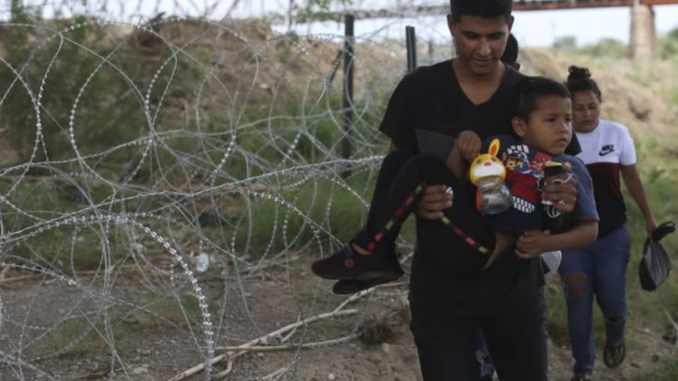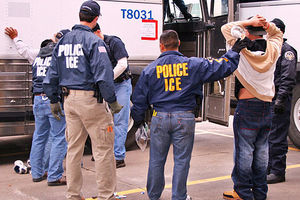
Texas has deployed more than 40 miles of razor wire and other border barriers along its boundary with Mexico, building a makeshift fence to plug gaps that the governor says the Biden administration left undefended from the migrant surge.
State prosecutors won their first conviction against an illegal immigrant for trespassing, as Texas moves to mete out criminal justice consequences that used to be the sole purview of the federal government.
Texas has been busing illegal immigrants straight to Washington and dropping them off near the U.S. Capitol. Gov. Greg Abbott, a Republican, has committed the state to build its own border wall, and he deployed the National Guard and state police at the border to help the feds and the locals.
The governor has emerged as the chief immigration foil for President Biden in the same way that blue-state governors led the charge against President Trump. But where Democrats pursued lenient policies by enacting sanctuary laws and extending benefits to illegal immigrants, Mr. Abbott is moving to station Texas as its own power in immigration enforcement with what he has dubbed Operation Lone Star.
“We are doing everything we possibly can to prevent people coming across the border and into the state of Texas,” the governor told reporters last week at a press conference held before the horrific school shooting in Uvalde.
The razor wire is the most visible move, and perhaps the most effective.
SEE ALSO: 1.35 million new illegal immigrants settled in U.S. under Biden, study shows
The Texas National Guard last week told The Washington Times that it had put up 42 miles of fencing and concertina wire — the official name for the looped strands of razor wire — since the start of Operation Lone Star.
The Trump administration deployed miles of wire when it faced migrant surges in 2018 and 2019. Mr. Trump called it “a beautiful sight,” though some of the communities where the wire went up said it looked threatening and endangered locals who might stumble into it.
Texas declined to talk about locations where the barriers have been placed, citing “operational security,” but the governor celebrated the extent of deployments.
“Our goal is to make sure we have that concertina wire in every inch of the border,” he said. “The only place we would be prohibited from putting it would be where federal land may be located, or if there’s private property where a private property owner does not want it.”
Razor wire serves as a sort of poor man’s border wall. It’s relatively easy to deploy and can often achieve the same thing as a larger and more permanent barrier: funneling illegal immigrants away from some locations and toward points where law enforcement can be waiting.
Increasingly, that means a state or local officer rather than a federal agent.
That was what led to the first trespassing jury trial last month in Kinney County, which has a sliver of the border near Del Rio and has become a major funnel point for illegal immigrants.
Lester Hidalgo Aguilar, a 39-year-old Honduran man, was convicted by a jury.
Tony Hackebeil, who led the prosecution, told jurors they had a chance to make a statement about the border, according to The Texas Tribune, which covered the trial.
“Send that message,” Mr. Hackebeil said. “Send the message to not just your community that you agree this should not be allowed to happen. But send a message as loud as you can to all of those people who are continually doing this.”
The jury deliberated for 20 minutes and found Aguilar guilty of trespassing on private ranchland, The Tribune reported. The judge slapped him with the maximum punishment of a year in jail.
Aguilar is one of more than 3,000 trespassing cases brought in Kinney County against migrant men.
Laura Pena, director of the Texas Civil Rights Project’s beyond borders program, said Texas has created “an illegal, separate state immigration enforcement agency.”
“The system is rife with due process and civil rights violations for U.S. citizens and non-U.S. citizens put through Operation Lone Star,” she said.
She said the cost so far runs to $4 billion.
“Border communities don’t want billions of dollars rerouted to razor wire, walls and more jails. Border communities want that money spent on what it was intended for — better access to health care, an education system that is safe and exciting for our children, and COVID relief funds to continue battling the pandemic,” Ms. Pena said.
Texas accounts for roughly half of illegal border crossers nabbed so far this year by federal agents and officers at Customs and Border Protection, and local officials say the surge has taken a toll on communities.
Filings in federal court cases detail the financial struggles that the state and counties face from handling the onslaught of migrants, with criminal justice, education and medical budgets all being tapped.
And there are more stark measures.
Zavala County, whose boundaries start a dozen or so miles off the border, brought in a temporary morgue to hold extra bodies of migrants who died trying to sneak through remote ranchlands, the governor said.
Some of Mr. Abbott’s supporters say there are steps he hasn’t taken but should.
One idea gaining steam in some border conversations is to have governors declare the surge of people an “invasion” under the U.S. Constitution. That would trigger another section of the Constitution that suggests states can raise their own armies if they are “actually invaded.”
The idea has been developed by some high-profile figures from the Trump administration, and Arizona Attorney General Mark Brnovich has issued a legal opinion saying his state’s governor could legally do it.
In Texas, a state legislator has asked Attorney General Ken Paxton for a similar ruling. George P. Bush, who had been challenging Mr. Paxton in a Republican primary but lost in a runoff election last week, said he backed the idea of an invasion declaration.
Texas and Arizona have deployed National Guard troops, but those who back the invasion strategy say there are too many limits on what the soldiers can do right now.
* Article from: The Washington Times


